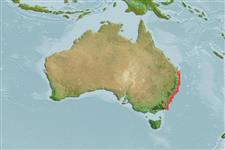Elasmobranchii (Haie und Rochen) (sharks and rays) >
Orectolobiformes (Carpet sharks) >
Parascylliidae (Collared carpet sharks)
Etymology: Parascyllium: para (Gr.), near, i.e., presumed to be related to Scyliorhinus (now in Scyliorhinidae): skylion, Greek for dogfish or small shark. (See ETYFish); collare: Latin for iron band or chain for neck, referring to prominent dark and unspotted collar around gills. (See ETYFish).
More on authors: Ramsay & Ogilby.
Environment: milieu / climate zone / depth range / distribution range
Ökologie
seewasser riff-verbunden; tiefenbereich 20 - 230 m (Ref. 106604), usually 55 - 128 m (Ref. 247). Temperate; 26°S - 38°S, 149°E - 154°E
Southwest Pacific: endemic to Australia.
Size / Gewicht / Alter
Maturity: Lm ? range ? - ? cm
Max length : 85.0 cm TL Männchen/unbestimmt; (Ref. 247); 87.0 cm TL (female)
Rückenflossenstacheln (insgesamt): 0; Rückenflossenweichstrahlen (insgesamt): 0; Afterflossenstacheln 0; Afterflossenweichstrahlen: 0. Gill region with a prominent dark brownish collar (Ref. 13572). Caudal fin with its upper lobe not elevated above the body axis, with a strong terminal lobe and subterminal notch but no ventral lobe (Ref. 13572).
A common but little-known shark found on the continental shelf, on or near rocky reefs or on firm bottom. Oviparous (Ref. 247, 43278). Probably of minor interest to fisheries (Ref. 13572).
Life cycle and mating behavior
Geschlechtsreife | Fortpflanzung | Ablaichen | Eier | Fecundity | Larven
Oviparous, paired eggs are laid. Embryos feed solely on yolk (Ref. 50449).
Compagno, L.J.V., 1984. FAO Species Catalogue. Vol. 4. Sharks of the world. An annotated and illustrated catalogue of shark species known to date. Part 1 - Hexanchiformes to Lamniformes. FAO Fish. Synop. 125(4/1):1-249. Rome, FAO. (Ref. 247)
IUCN Rote Liste Status (Ref. 130435)
Bedrohung für Menschen
Harmless
Nutzung durch Menschen
Fischereien: kleinfischerei
Mehr Information
ReferenzenAquakulturAquakultur ProfilZuchtlinienGenetikElectrophoresesVererbbarkeitKrankheitenVerarbeitungNutrientsMass conversion
PartnerBilderStamps, Coins Misc.LauteCiguateraGeschwindigkeitSchwimmstilKiemenoberflächeOtolithsGehirngrößeSehfähigkeit
Tools
Zusatzinformationen
Download XML
Internet Quellen
Estimates based on models
Preferred temperature (Ref.
123201): 16 - 20.3, mean 19.5 °C (based on 7 cells).
Phylogenetic diversity index (Ref.
82804): PD
50 = 0.5352 [Uniqueness, from 0.5 = low to 2.0 = high].
Bayesian length-weight: a=0.00389 (0.00180 - 0.00842), b=3.12 (2.94 - 3.30), in cm total length, based on all LWR estimates for this body shape (Ref.
93245).
Trophic level (Ref.
69278): 3.8 ±0.6 se; based on size and trophs of closest relatives
Widerstandsfähigkeit (Ref.
120179): niedrig, Verdopplung der Population dauert 4,5 - 14 Jahre. (Fec assumed to be <100).
Fishing Vulnerability (Ref.
59153): Moderate to high vulnerability (55 of 100).
Nutrients (Ref.
124155): Calcium = 4.39 [0.63, 17.64] mg/100g; Iron = 0.136 [0.034, 0.380] mg/100g; Protein = 19.6 [17.4, 21.7] %; Omega3 = 0.264 [0.113, 0.604] g/100g; Selenium = 8.18 [2.30, 24.77] μg/100g; VitaminA = 37.1 [10.5, 133.0] μg/100g; Zinc = 0.417 [0.198, 0.902] mg/100g (wet weight);
